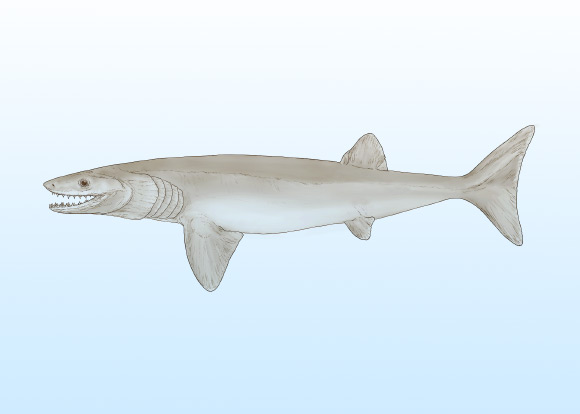A team of paleontologists from California State Polytechnic University and elsewhere has described a new genus and species of shark-like fish from the Late Mississippian Fayetteville Shale of Arkansas, United States.
An artist’s reconstruction of Cosmoselachus mehlingi. Image credit: American Museum of Natural History.
The newly-described species lived in the Devonian oceans, approximately 326 million years ago.
Named Cosmoselachus mehlingi, it is one of many well-preserved fossil sharks from the oil-bearing Fayetteville Shale Formation, which stretches from southeastern Oklahoma into northwestern Arkansas and has long been studied for its well-preserved invertebrate and plant fossils.
“These creatures are part of a recovered ecosystem following a major extinction of fish groups at the end of the Devonian period, so it’s a time of incredible morphological diversity in cartilaginous fishes, including all kinds of weird anatomy we don’t see in modern sharks,” said Dr. Allison Bronson, a researcher at California State Polytechnic University.
The fossil of Cosmoselachus mehlingi was collected in the 1970s by Ohio University professors Royal and Gene Mapes.
Dr. Bronson and colleagues CT-scanned and digitally reconstructed the specimen.
They worked for many months to describe its anatomy, including dozens of tiny pieces of cartilage.
Once the reconstruction was complete, they placed Cosmoselachus mehlingi in the tree of life of early cartilaginous fishes.

Cosmoselachus mehlingi, photographed in the 1970s, positioned to show the underside of the throat, jaws, and pectoral fins. Image credit: Royal Mapes.
The authors found that the new species plays an important role in understanding the evolution of an enigmatic group called the symmoriiforms.
“This group has alternately been linked with sharks and ratfish, with different researchers coming to different conclusions,” they said.
“Cosmoselachus mehlingi has mostly shark-like features, but with long pieces of cartilage that form a gill cover, which is only seen in ratfish today.”
The study was published in the journal Geodiversitas.
_____
A.W. Bronson et al. 2024. A new operculate symmoriiform chondrichthyan from the Late Mississippian Fayetteville Shale (Arkansas, United States). Geodiversitas 46 (4): 101-117; doi: 10.5252/geodiversitas2024v46a4


